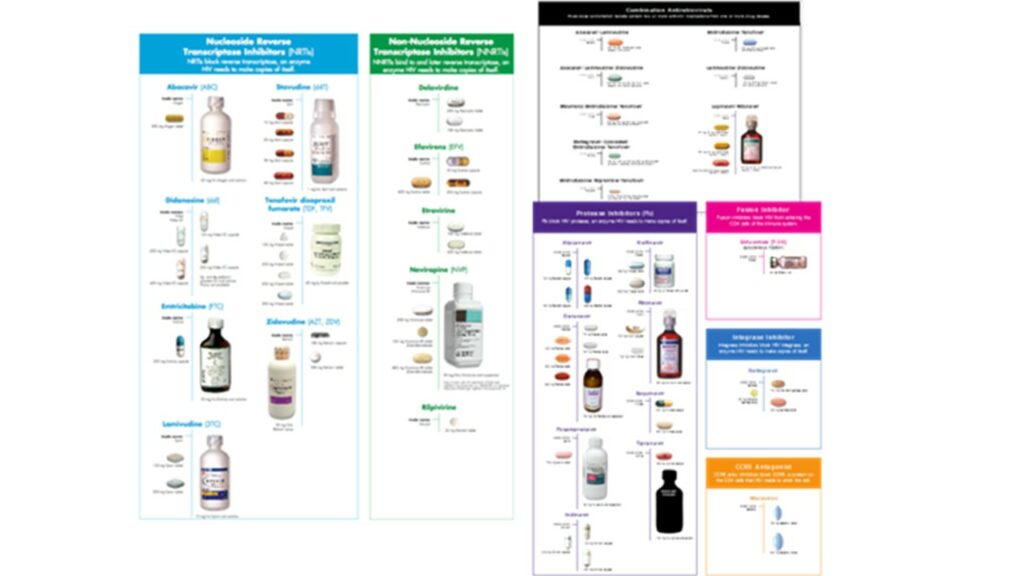What is Human Immunodeficiency Virus (HIV-1)?
HIV-1 is a virus that attacks the immune system. It primarily targets CD4+ T cells − types of immune cells − that are necessary for fighting off infections of all kinds. This virus integrates into immune cell DNA, which is how it becomes a chronic, lifelong infection. If left untreated, HIV-1 can impair the immune system’s ability to fight off other infections and diseases.
The graph on the right shows the relationship between virus levels in blood (red line) and numbers of CD4+ T cells (blue line) over time. During acute infection, virus levels are high until immune responses develop. However, since HIV-1 mutates rapidly, an ongoing struggle of control continues between the virus and the immune system. If left untreated, a continuing loss of immune cells eventually weakens the ability to fight off other infections.

What is cART?

Combination Antiretroviral Therapy (cART) is the standard of care therapeutic treatment for HIV-1 infection. It consists of a combination of drugs primarily targeting virus replication. However, since HIV-1 mutates so fast, one drug may not be sufficient to manage the infection. If cART drugs are maintained, it is possible to control virus levels in blood, reduce risks of transmission and minimize the loss of immune cells.
Current HIV-1 Therapeutic Drugs

- To maintain virus suppression, adherence to cART drugs is required.
- Even when HIV-1 is fully suppressed by cART, some virus remains in a dormant state, as part of the viral reservoir. Unfortunately, cART does not directly affect the viral reservoir. The reservoir is a source of rebounding virus when cART therapy is interrupted.
- The lifetime cost treatment management for a person living with HIV-1 infection in the U.S. is estimated at over a million dollars. The cost of managing comorbidities while living with HIV infection is rising. New therapeutic strategies are being developed.
- HIV-1 mutates so rapidly that therapies may need to be changed. This is especially important if treatment is interrupted.
Common Misconceptions
HIV-1 is still quite misunderstood throughout the world. Below are some common myths about the virus. Click on the underlined text for more information.
Myth: HIV is no longer a problem.
Fact: HIV is a chronic, lifelong infection that currently has no cure nor vaccine. The virus persists in blood and in tissues, even when viral loads are undetectable in plasma. Reducing persistent sources of virus is the current goal of new therapeutic strategies, one of the priorities for the Division of AIDS at NIH.
Myth: HIV can be spread through contact such as kissing, holding hands, or sharing utensils.
Fact: HIV is spread primarily through sexual contact, and through blood. HIV is not known to transmit from saliva, sweat, or tears. The virus can sometimes be spread through childbirth or breastfeeding, but this can be prevented with medicines. If a person has been taking antiretroviral drugs every day, the risk of spreading the virus is reduced. HIV cannot be spread by mosquitoes.
Myth: HIV has stopped spreading.
Fact: While the rates of new HIV infections have declined over the last few decades, there are still millions of new cases of HIV every year.
Myth: Now that there are treatments for HIV, everyone has access to those drugs.
Fact: Medications have drastically improved and increased the lifespans of many HIV-infected people, but not everyone has access to that care. Nearly one quarter of HIV- infected people in the world still do not have access to the treatments that would save their lives. Without medications, HIV can progress to AIDS.
Myth: HIV mostly impacts older people.
Fact: The largest proportion of new cases of HIV infection in the United States between 2013-2019 has been occurring in younger people between 25 and 34 years of age (Fast Facts: HIV in the US by Age | HIV | CDC).
Myth: HIV is only a problem outside the U.S.
Fact: While some countries have higher rates of HIV infection, this virus can be found anywhere in the world. HIV can have an impact anywhere people live, including the U.S.